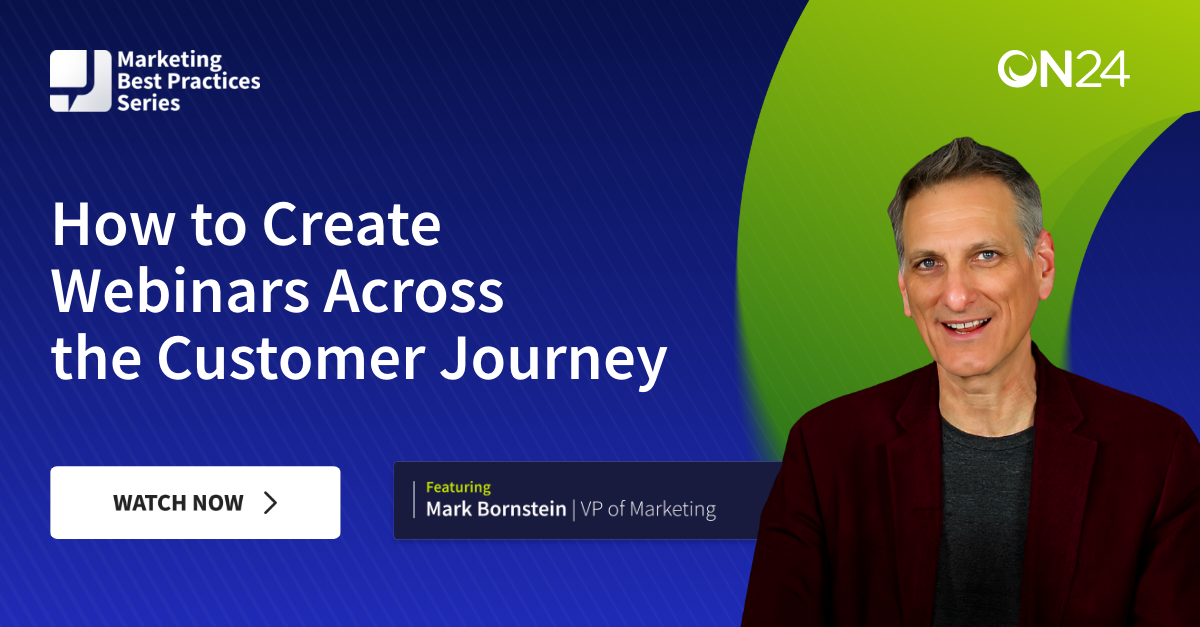Crafting a Successful Customer Engagement Journey

When you engage with a customer, what happens? They, the customer, decide to take a next step, whether that’s clicking a link, booking a demo, signing a contract or attending a webinar. That — a series of interactions between a customer and a business — is the customer engagement journey.
A customer engagement journey — a subset of the customer journey — details the actions customers take as they work through the marketing funnel. It helps maintain a positive brand perception, nurture relationships and cultivates advocacy.
But how do you realize the benefits of customer engagement? It starts with planning. Read on to learn how you can craft a successful customer engagement journey.
Importance of Mapping Out the Customer Journey

The goal of any customer engagement program is to meet customer needs. To do that, you need to plan. Sit down and map out your customer journey before drafting a customer engagement strategy. By doing so, you’ll identify your primary customer touchpoints, have a better perspective of your customer experience and identify opportunities for improvement.
Customer journey maps are usually built around five phases:
-
- Awareness – when the customer recognizes a need or problem and becomes aware of your brand’s solution.
-
- Consideration – the customer actively begins to seek out different product or service offerings, often comparing brands to see which one best fits their needs.
-
- Decision – during the decision stage, the customer makes their final choice and proceeds with the purchase, crossing the threshold from prospect to customer.
-
- Retention – having used your product or service, the customer continues interacting with your brand, potentially making further purchases.
-
- Advocacy – satisfied with their experience, the customer recommends your brand to others, fueling the start of the cycle.
Your customer journey doesn’t have to follow this five-stage process, but it’s a good starting point from which to build. It’s also worth remembering that customers may jump back and forward throughout the journey.
The Role of Touchpoints in the Journey
Touchpoints are the moments of interaction between your business and customers. Combined, they make up the customer engagement journey. They can be formed from direct or indirect contact and can take place via any medium.
For example, if a customer finds out about your brand from an online search, the first touchpoint is them seeing your brand’s listing on the search engine results page (SERP). For existing customers, touchpoints might include marketing emails and customer service interactions.
Touchpoints have a significant impact on the customer experience. When they are timely, relevant, and offer value, they help guide customers through the journey and positively influence decision-making.
Stage 1: Attracting Prospects

The first stage of the customer engagement journey is focused on attracting potential customers. Without prospects to convert, subsequent stages aren’t possible – so it’s crucial to get this right.
Strategies for Attracting Potential Customers
Attracting prospects is all about raising brand awareness. You’ll need to employ strategies that capture attention and generate interest, such as the following:
-
- Search marketing – with search engine optimization (SEO) and pay-per-click (PPC) advertising, you can reach potential customers via SERPs.
-
- Social media – influencer collaborations, paid social advertising, and viral organic posts can all introduce your brand to a new audience.
-
- Content marketing – become a trusted industry source and attract new customers by creating high-quality content that addresses your target audience’s needs and interests.
-
- Customer advocacy – social proof states that people are more likely to engage with a brand if they know others have. This makes customer reviews and referral schemes powerful tools for attracting prospects.
Creating Compelling Content and Marketing Campaigns
Content must be compelling to attract and retain customer interest. The same goes for marketing campaigns in general. But to compel your audience means to get inside their heads and to do that, you’ve got to know what makes them tick.
Once you understand the unique paint points, preferences and behaviors of your target audience, you can craft engaging messages that genuinely resonate. Consider which mediums will allow you to deliver these messages most clearly while still aligning with your audience’s preferences.
Images and videos can help make your content more digestible, while introductory offers add a compelling quality to marketing campaigns. You can also leverage storytelling to forge emotional connections that fuel engagement.
Use Social Media and Advertising Channels
Social media offers varied ways to attract new customers and re-engage past customers who have stopped interacting with your brand. Through organic posts, you can reignite interest and promote new service offerings that pull customers back into the top of the funnel.
Shareable content like competitions and thought leadership posts can help you reach new audiences across platforms like LinkedIn. You can also run paid advertising across different social platforms to raise brand awareness and promote demand generation tactics such as webinars and virtual events.
Other advertising platforms like Google Ads help connect you with potential customers who are actively seeking the services that you offer. These platforms usually include comprehensive analytics that allow you to continually optimize your ads and create multiple touchpoints, priming your prospects for conversion.
Stage 2: Converting Leads

The ultimate aim of a digital engagement strategy is to convert leads into paying customers so that your business makes revenue. This is the end goal as you nurture prospects through the customer journey, and all phases work together to help you achieve it.
Techniques for Converting Prospects into Customers
Converting leads into customers requires guiding prospects seamlessly through the consideration and decision stages of the journey. Now is the time to:
-
- Highlight your value proposition – identify your audience’s problems and demonstrate how your brand offers a solution. You can use case studies and comparisons to highlight why your brand is the best choice.
- Showcase your expertise – convince customers of your expertise with on-demand content hubs, thought leadership content, and powerful customer testimonials.
- Cultivate personalized experiences – use data to tailor the customer engagement journey to each prospect’s needs and preferences with personalized communications and recommendations.
- Reinforce compelling offers – offers such as free trials and limited-time promotions create a sense of urgency and directly encourage prospects to take action.
Optimizing Landing Pages and Calls-to-Action
Effective landing pages and calls-to-action (CTAs) are the backbone of driving conversions. To ensure that these critical aspects are working to their full potential, they should each be optimized around a single, clear conversion goal (e.g. a “buy now” button, sign-up link or contact form submission).
On landing pages, copy should be clear and concise, with headlines that immediately convey the page’s purpose. Visual CTAs will help break up large chunks of copy and make it easier for the customer to engage.
Continuous testing is key to sustaining good conversion rates over the long run. A/B test different text, designs, button colors, and anything else you can think of to find out what works best for different customer segments.
Implementing Effective Lead Nurturing Strategies
A successful customer engagement journey will nurture leads into customers and build lasting relationships. But much like in day-to-day life, the most successful relationships don’t follow a one-size-fits-all approach.
To nurture leads effectively, you’ll need to craft personalized experiences that take into account the individual’s interests, behavior and stage of the journey they’re at. Lead segmentation is the way to do this, and with engagement tracking tools, you’ll be able to nurture different segments as they move through the journey.
Automated email campaigns can be triggered based on customer interactions to provide key information and nudge leads closer to making a decision. To avoid making prospects feel like they’re being bombarded with sales tactics, providing access to educational content they can explore in their own time can also be beneficial.
Stage 3: Building Loyalty and Advocacy

The customer engagement journey doesn’t end post-conversion. In fact, it’s arguably what happens after this point that will define the long-term success of your business.
Importance of Building Long-Term Relationships with Customers
Treating a sale as the end of the customer engagement journey is almost equivalent to throwing money away. You’ve spent time, effort and resources to secure a new customer, only to turn away from them at the point when they’re most engaged.
Gitnux’s 2024 Market Data report shows that the chance of selling to an existing customer is 60-70%. For new prospects, the statistic is 5-20%. This is because the previous stages of the engagement journey act as a filtering process. By the end, you’re left with customers who already know, trust and find value in your brand.
These long-term relationships increase your customer lifetime value (CLV)—the profit generated per customer. As your loyal customers continue to buy from and engage with your brand, the more data you gather, the more you will optimize future touchpoints to achieve further sales.
Providing Exceptional Customer Service
Good customer service is one of the biggest brand loyalty drivers. When customers receive exceptional service, they feel listened to and grow confident in your brand’s ability to meet their needs. Here are some ways you can enhance yours:
- Employee training – ensuring that employees are friendly and professional while understanding company processes inside out is the first step to achieving better customer service.
- Contact methods—Offering a variety of ways to get in touch (e.g., email, live chat, phone) gives the customer flexibility and emphasizes their needs.
- Response times – answering customer queries quickly to minimize frustration and provide reassurance.
- Information availability – onsite FAQ pages and timely email communications can solve customers’ questions before they’ve even had a chance to ask.
Encouraging Customer Feedback and Reviews
Your customers are your business’s best advocates, but they’re also one of your best sources of inspiration. Collecting feedback and reviews helps you improve your offering and signify your trustworthiness to potential customers.
While some customers will provide this information unprompted, others might need to be persuaded. Incentivizing reviews can be very effective, and actively responding to feedback will make customers feel it’s worth their effort.
Remember to showcase positive reviews on your website and other marketing materials to maximize the benefits. Highlighting areas where you’ve implemented customer feedback can also instill trust.
Technology for Customer Engagement

Technology plays a vital part in the customer engagement journey, facilitating not only interactions between customers and businesses but also the ability to track, personalize, and scale these interactions.
With CRM platforms, automation and personalization tools, AI-powered chatbots, analytics tools, and content creation/distribution platforms, marketers can enhance the customer experience and streamline their workflows.
ON24’s digital engagement solution offers seamless integration with your CRM and other business systems to drive customer engagement forward. You can build cohesive journeys across multiple touchpoints and platforms while collecting detailed engagement data to optimize each step. Contact us to find out more.

